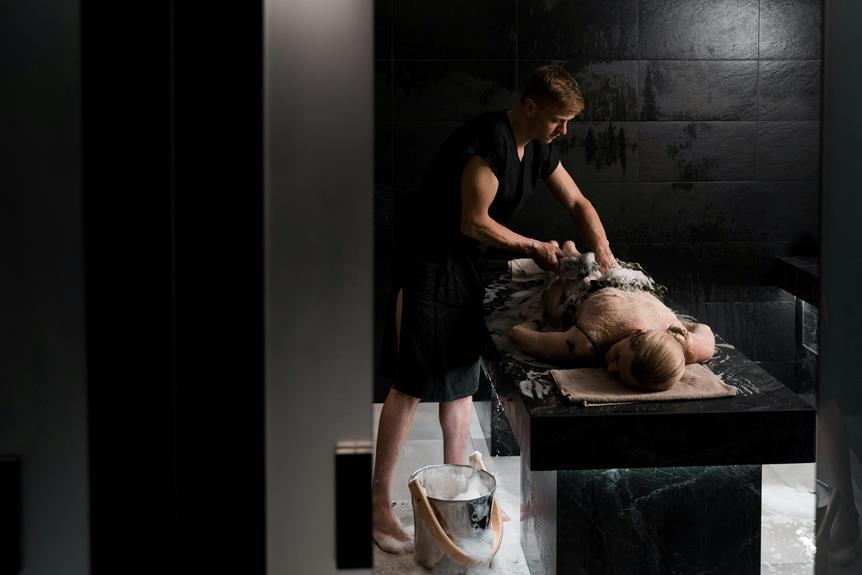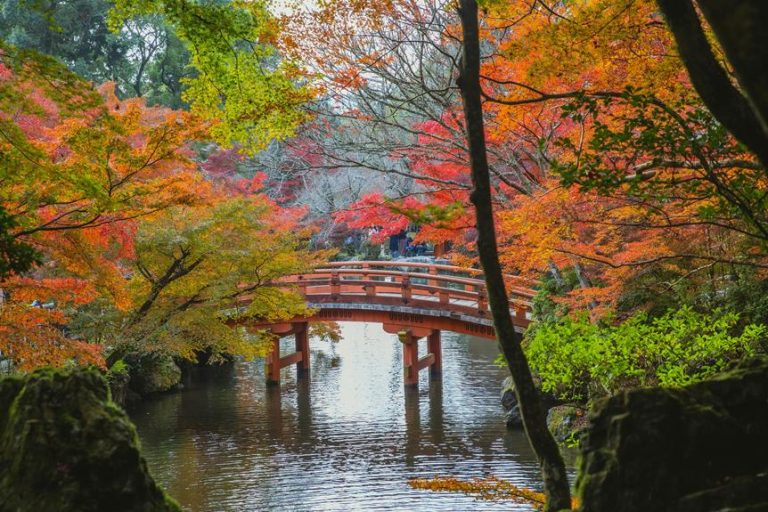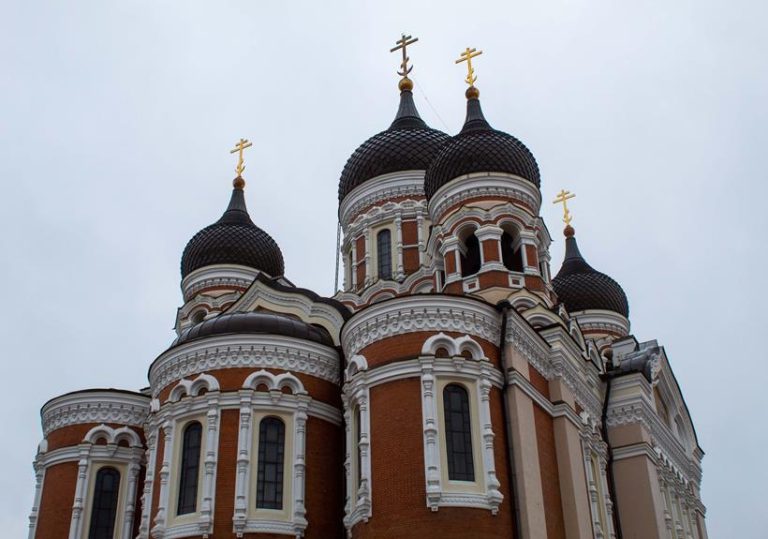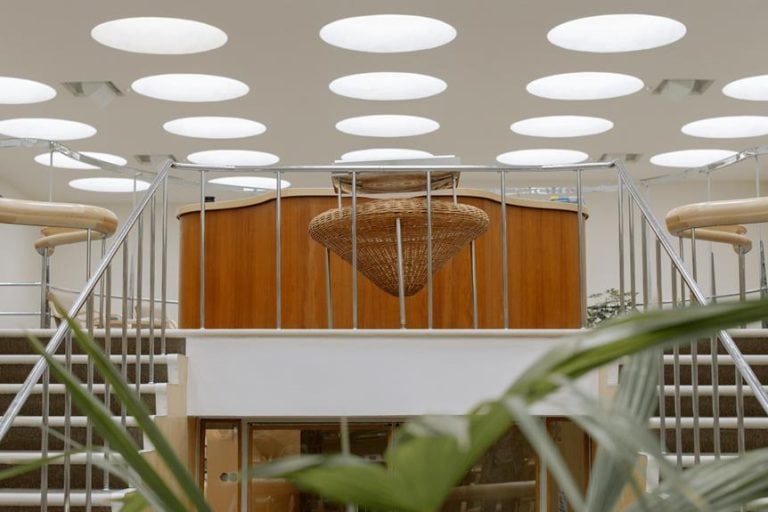What Defines the Traditional Russian Banya Sauna?
Stepping into a traditional Russian banya sauna is like entering a world where time stands still and worries melt away, much like the steam that envelops you.
But what exactly defines this iconic Russian bathing ritual? From its ancient origins to the unique features that set it apart, there's much to explore.
So, let's dive into the steamy depths of the banya sauna and uncover the secrets that make it a cherished tradition for millions.
Key Takeaways
- The traditional Russian banya sauna has a long history and unique characteristics compared to other saunas.
- The banya sauna involves rituals like the venik treatment, hat-wearing, and cooling off to enhance the experience.
- The banya sauna offers various health benefits, including skin rejuvenation, toxin elimination, and improved blood circulation.
- The banya sauna holds cultural significance in Russian society and is associated with important social milestones and mythology.
Origins of the Banya Sauna
The origins of the Banya Sauna can be traced back to early Slavic writings and traditions, where the practice of steam bathing was an integral part of their culture. Early mentions of banyas in Russian history date back over a thousand years, making it a longstanding tradition in the region. The Russian banya sauna shares similarities with the Finnish sauna, which also originated in central and eastern Europe. However, the Russian banya sauna has its own unique characteristics.
One of the main differences between the Russian banya sauna and the Finnish sauna is the high heat and low humidity. While Finnish saunas are known for their dry heat, Russian banyas typically maintain temperatures around 70°C with higher humidity levels. This combination creates a unique experience for those indulging in the traditional banya sauna.
The traditional banya sauna isn't just a place for relaxation, but also holds cultural significance. It's a place where friends and family gather, socialize, and enjoy the benefits of steam bathing. The banya sauna is seen as a place of cleansing and rejuvenation, both physically and spiritually. It's a cherished tradition that has been passed down through generations, preserving the essence of the Slavic culture.
Key Features of the Banya Sauna
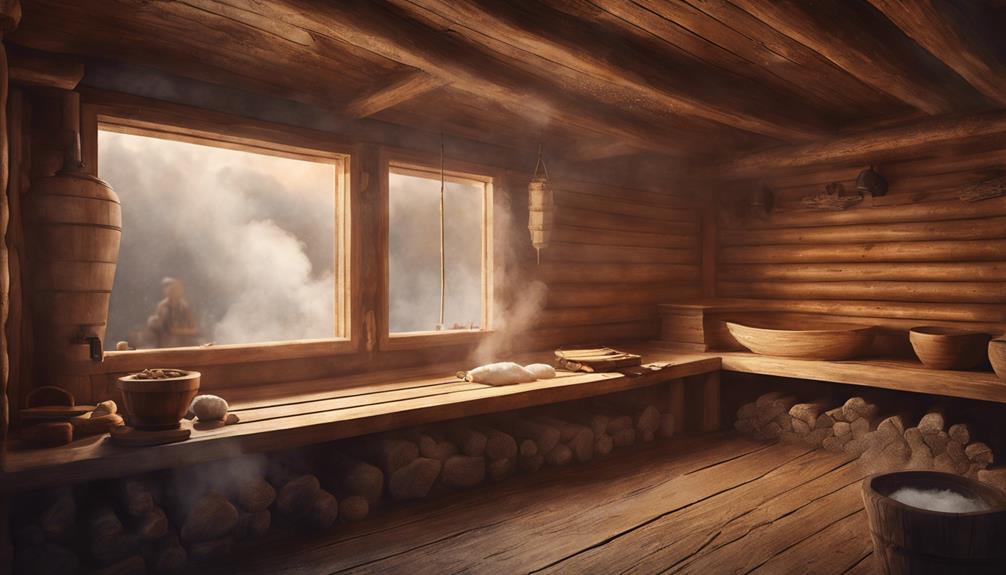
After exploring the origins and cultural significance of the traditional Russian banya sauna, it's now time to delve into its key features that make it a truly unique and immersive experience.
- The Steam Room: The heart of the banya sauna is the steam room, where hot water is poured over heated rocks to create a dense and invigorating steam. The high humidity and elevated temperature help open up the pores, promoting detoxification and relaxation.
- The Venik Ritual: One of the most distinctive features of the Russian banya is the use of birch branches, known as venik. These branches are soaked in hot water and then used to gently beat the body, improving circulation and stimulating the skin. This ancient practice is believed to have numerous health benefits.
- Cooling Off: After experiencing the intense heat of the steam room, cooling off is a customary ritual in traditional Russian banyas. Many banya-goers opt for plunging into cold water or even rolling in the snow to regulate their body temperature and invigorate their senses.
In addition to these key features, visitors in a Russian banya often wear felt hats to protect their heads from the heat. The heating process itself, involving water being poured over hot rocks, creates a unique and therapeutic environment. To enhance the experience, homemade herb extracts and teas are commonly used for massage and relaxation. Whether it's the steam room, the venik ritual, or the cooling off process, the key features of a traditional Russian banya sauna contribute to its rejuvenating and immersive nature.
Rituals and Traditions in the Banya Sauna
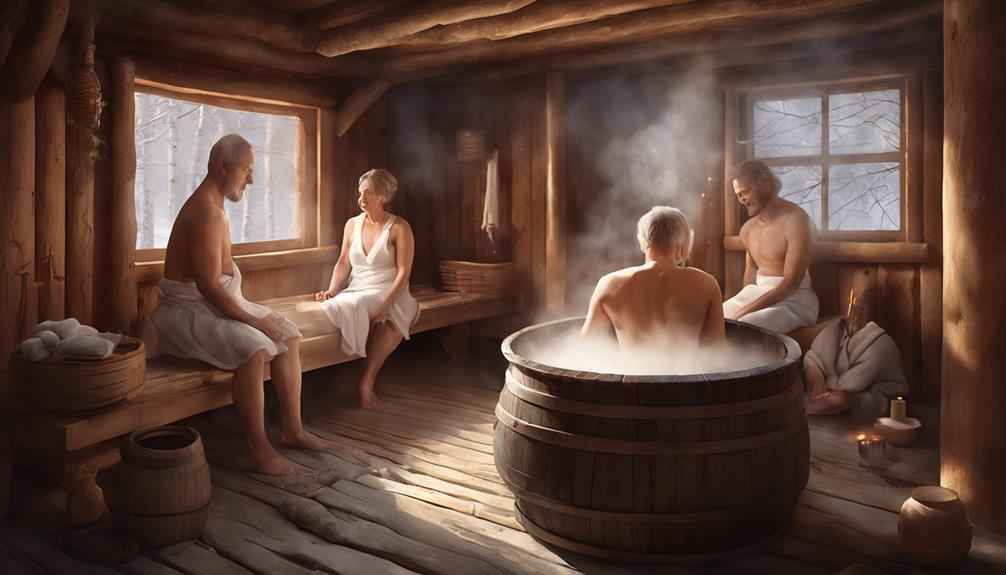
Engaging in a variety of rituals and traditions, the banya sauna offers a unique and immersive experience for its visitors. One of the fundamental rituals in the Russian banya sauna is following a heat-cool cycle. This involves spending time in the hot steam rooms, allowing the body to sweat and release toxins, followed by cold water or snow immersion to cool down and invigorate the senses. This alternating between extreme temperatures is believed to have numerous health benefits.
Another distinctive tradition in the banya sauna is the use of veniks, or bath brooms made from branches like birch or oak. These veniks are used for self-massage, gently tapping the body to improve blood circulation and stimulate the skin. The sensation of the veniks, combined with the aromatic scents they release, creates a rejuvenating experience.
In addition to the use of veniks, wearing felt hats is common in the banya sauna. These hats provide protection for the head and help to regulate body temperature. It's also customary for guests to engage in light lashings with the veniks, which is believed to improve blood circulation and promote overall wellness.
Moreover, the banya sauna is a place for relaxation and socialization. Traditional rituals include enjoying snacks and herbal tea in the entrance room, where visitors can unwind and connect with friends. This social aspect is an integral part of the banya sauna experience, enhancing the sense of community and well-being.
The banya sauna is a rich cultural tradition with rituals and traditions that have been passed down through generations. From the heat-cool cycle to the use of veniks and the socialization aspect, these practices create a truly authentic and immersive experience in the Russian banya sauna.
Health Benefits of the Banya Sauna
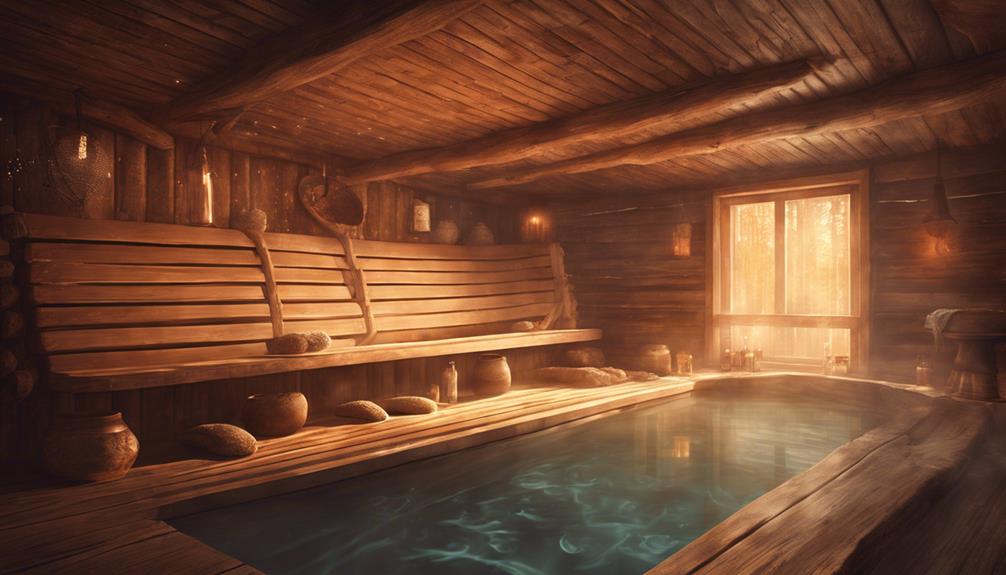
Immersing oneself in the traditional Russian banya sauna offers a multitude of health benefits that go beyond mere relaxation. The hot steam and bath brooms used in the banya sauna promote skin cleansing and rejuvenation, leaving your skin feeling refreshed and revitalized. The combination of heat and steam opens up your pores, allowing for a deep cleanse that removes dirt, oil, and impurities from your skin. This process not only improves the appearance of your skin but also helps to prevent breakouts and acne.
Furthermore, the banya sauna aids in eliminating toxins from your body, contributing to weight loss and overall health improvement. As you sweat in the sauna, your body releases toxins and impurities through your pores, helping to cleanse your system from the inside out. This detoxification process can also help boost your metabolism and aid in weight loss.
In addition to its skin cleansing and detoxifying benefits, the traditional Russian banya sauna is believed to have anti-aging effects on the skin and body. The combination of heat and steam stimulates blood circulation, which can help improve the elasticity and firmness of your skin. This can reduce the appearance of wrinkles and fine lines, giving you a more youthful and radiant complexion.
Cultural Significance of the Banya Sauna
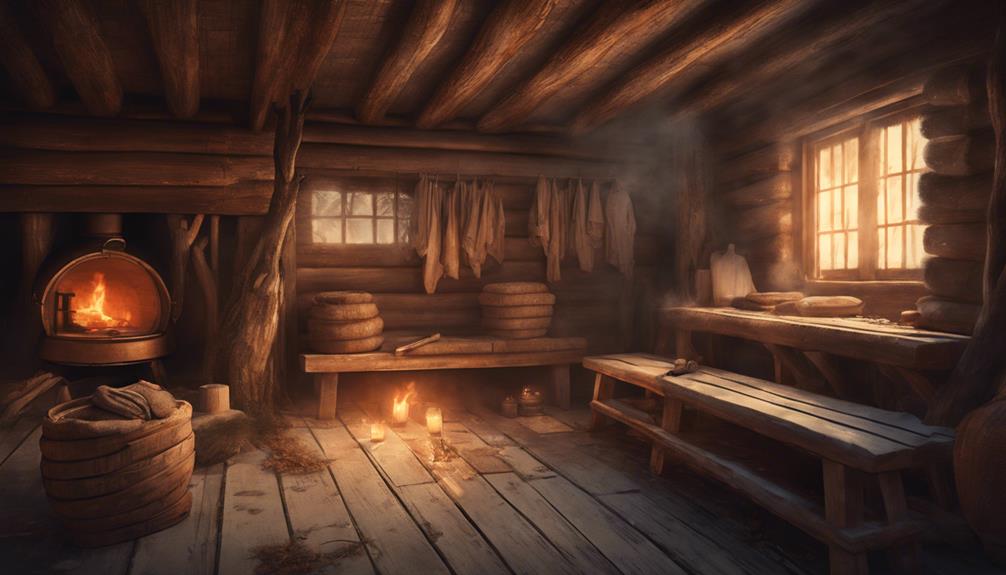
The cultural significance of the traditional Russian banya sauna is deeply ingrained in Russian society, permeating all aspects of life and serving as a cornerstone in important rituals and gatherings. In Russian culture, the banya sauna is more than just a place to relax and cleanse the body; it holds a special place in the hearts of the people. With its historical beliefs in the healing properties and health benefits of the banya sauna, it has become an essential part of Russian tradition.
Throughout history, banyas have been associated with various social gatherings and celebrations. They're often used to mark important milestones in life, such as births and marriages. The banya sauna is seen as a place of purification, where individuals can cleanse their bodies and souls before embarking on a new chapter of their lives.
The cultural significance of the banya sauna can also be seen in its connection to Slavic mythology. According to ancient beliefs, banyas were inhabited by spirits who possessed the power to heal and rejuvenate. This connection to mythology adds a sense of mysticism and reverence to the banya sauna, further enhancing its cultural significance.
Furthermore, the banya sauna has been featured prominently in Russian art and literature, showcasing its cultural importance. From paintings to poems, the banya sauna is often depicted as a symbol of Russian identity and tradition. It serves as a reminder of the rich heritage and customs that have been passed down through generations.
Comparisons With Other Sauna Traditions

When comparing the traditional Russian banya sauna to other sauna traditions, it becomes evident that there are distinct differences in temperature, humidity levels, and unique practices.
- Temperature and humidity: The Russian banya sauna typically operates at temperatures around 70°C with higher humidity levels of 40-60%. In contrast, the Finnish sauna tradition involves temperatures of around 90°C with low humidity levels ranging from 5-10%. The Russian banya sauna offers a slightly cooler environment, allowing for a more comfortable experience.
- Hat and water rituals: Users in the Russian banya sauna wear hats for protection, while sauna users in the Finnish tradition don't require them. This is due to the higher humidity levels in the Russian sauna, which can cause hair follicles to become more susceptible to heat damage. Additionally, unique to the Russian banya experience is the practice of dousing in cold water, using bucket showers, and plunge pools for cooling off. This contrasts with the Finnish sauna tradition, where water isn't typically used in the sauna room.
- Venik treatment: The use of venik treatment is a distinctive feature of the Russian banya sauna. Venik refers to bunches of birch or oak tree branches that are soaked in water and then lightly beaten against the body. This practice is believed to improve blood circulation and stimulate the release of toxins. It isn't commonly found in other sauna traditions.
Frequently Asked Questions
What Is the Russian Tradition of the Sauna?
The Russian tradition of the sauna, known as the banya, has deep roots in Russian culture and history. It promotes good health, relaxation, and social bonding through rituals and traditions like venik massage and herbal tea.
What Is the Difference Between a Sauna and a Banya?
In a banya, the difference lies in the higher humidity and unique rituals like dousing in cold water. It's a cultural experience with health benefits, using steam rooms and herbal remedies. The architecture and social aspects make it truly special.
What Is the Story of the Banya in Russia?
The banya has a rich history in Russia, dating back centuries. It holds great cultural significance, with traditional rituals and practices passed down through generations. The banya has evolved over time, serving as a social gathering place and offering numerous health benefits. Etiquette and rules govern the banya experience, and famous banyas can be found throughout Russia. Its influence on Russian literature and art is undeniable.
How Hot Is the Russian Banya Sauna?
The Russian banya sauna is typically heated to temperatures ranging from 70°C to 90°C. The high heat promotes sweat detoxification and offers various health benefits. It is an essential part of traditional practices and holds cultural significance.
Conclusion
In conclusion, the traditional Russian banya sauna offers a unique and holistic bathing experience. It combines steam sessions, self-massage with veniks, and a social atmosphere. Its origins, key features, rituals, and health benefits make it a truly special tradition.
Just as the heat-cool cycle of the banya sauna rejuvenates the body, the social atmosphere and shared experiences within it can rejuvenate the soul. Like the branches of the veniks, the banya sauna brings people together, creating a sense of openness, friendship, and connection.

